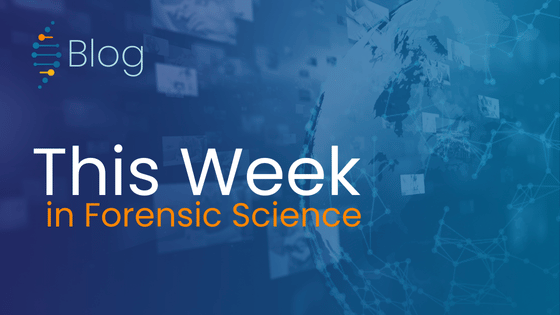No one has hours to scour the papers to keep up with the latest news, so we’ve curated the top news stories in the field of Forensic Science for this week. Here’s what you need to know to get out the door!

The Mystery of an Ancient Skull Takes a New Turn after DNA Analysis (The Washington Post – 1/18/2025)
The skull of a person long thought to be Cleopatra’s half sister was misidentified for nearly a century, new research from Nature Scientific Reports concludes, raising intriguing questions about the identity of its long-dead teenage owner.
The well-preserved skull and some skeleton fragments were found in Ephesus, Turkey, buried in a sarcophagus in the Octagon, which is thought to be a royal burial chamber and shares architectural features with buildings in Alexandria, Egypt, a group of researchers in Austria and Portugal write. Scientists thought its similarities to buildings from Ptolemaic Egypt — and the body found inside — meant it had been erected in memory of Cleopatra’s half sister, Arsinoë IV.
Cleopatra herself is thought to have ordered the murder of her younger sister, who briefly challenged her place on the Ptolemaic dynasty’s throne and lived much of her short life in exile before being assassinated on Mark Antony’s orders in 41 B.C. So when the skeleton of an “obviously notable person” was uncovered there, the researchers write, its discoverers concluded it belonged to Arsinoë.
That assumption was mistaken, the new analysis suggests. Using modern DNA analysis, researchers found that the cranium and its accompanying skeleton are actually those of an 11-to-14-year-old boy with recent ancestors in the Italian peninsula or Sardinia, not a 20-year-old woman or a member of the Macedonian-Greek Ptolemaic dynasty. The skull also challenged assumptions that the person was healthy, with an underdeveloped upper jaw and asymmetrical shape suggesting he had a vitamin deficiency or genetic disorder.
Wisconsin Innocence Project to Use $1.5M Grant to Revisit Old Cases with New Technology (Wisconsin Public Radio – 1/20/2025)
A three-year grant from the U.S. Department of Justice will allow the Wisconsin Innocence Project to look back at its past cases and reinvestigate them using recent advancements in DNA technology.
At $1.5 million, the grant is the largest in the Wisconsin Innocence Project’s History. Rachel Burg, who directs the legal clinic, said it could be a game-changer.
Build a DNA Database to Help Identify Children Stolen in Conflicts (Nature – 1/21/2025)
Conflicts in Ukraine, Gaza, Sudan, Syria and elsewhere have exacerbated a global missing-persons crisis. There is an urgent need for an international DNA database designed specifically to aid the reunification of living family members. Such a database would help to lessen the trauma of those who have been separated. It would also help to provide evidence of human-rights violations.
Since Russia’s invasion of Ukraine almost three years ago, nearly 20,000 Ukrainian children have been taken to Russia. In December, investigators at the Yale School of Public Health Humanitarian Research Lab in New Haven, Connecticut, discovered that 314 of these children, from the Donetsk and Luhansk provinces, had been placed in a “systematic program of coerced adoption and fostering” in Russia1. Because Russia gives adoptive parents the legal right to change a child’s name and official date and place of birth, the children’s Ukrainian identities could have been erased. A similar fate might have befallen many of the others. A DNA database of Ukrainian families who have lost children is crucial to help these families reconnect — now and in the future. Years or decades from now, these children might learn of their Ukrainian heritage and want to find their living relatives.
Smith vs. Arizona: The Decision, the Forensic Fallout, and the Legal Path Forward (DNA Labs International – 1/21/2025)
Smith v. Arizona: The Decision, the Forensic Fallout, and the Legal Path Forward The United States Supreme Court’s June 2024 decision in Smith v. Arizona will potentially impact both laboratory operations and the presentation of expert testimony in the United States. This webinar will take an in-depth look at the legal issues, the Smith holding, and its’ possible fallout on forensic laboratories around the country. Lower court decisions following Smith will be examined, and emerging issues and trends will be identified and discussed. This webinar will also share several legal strategies that adhere to Smith’s holding while avoiding the need to call unnecessary witnesses and disrupt laboratory operations.
Presenter: Ted Hunt. Senior Policy Advisor. FBI Laboratory Division
Moderator: Rachel Ofelein. Chief Scientific Officer & Laboratory Director. DNA Labs International
Las Vegas Metropolitan Police Department Teams with Othram to Identify a 2001 Homicide Victim (DNASolves – 1/22/2025)
In January 2001, the partial skeletal remains of an unidentified individual were discovered in Las Vegas, Vegas in the area of Pabco and Sunset Roads. A search of the area resulted in the discovery of additional remains, leading investigators to conclude that the person had been buried in a shallow grave alongside burnt pieces of wood, bushes, and several large pieces of concrete or rocks. It was determined that the woman died as a result of homicide.
The woman could not be identified and became known as Las Vegas Jane Doe. Details of the woman’s case were entered into the National Missing and Unidentified Persons System (NamUs) as UP250. Despite investigators’ efforts, the woman was identified for more than twenty years when the Las Vegas Metropolitan Police Department teamed with Othram to determine if the woman could be identified using advanced DNA testing.
In 2021, Las Vegas Metropolitan Police Department submitted forensic evidence to Othram’s laboratory in The Woodlands, Texas where scientists worked to extract DNA from the provided evidence. A comprehensive DNA profile was developed using Forensic-Grade Genome Sequencing® to enabling Othram’s in-house forensic genetic genealogy team to develop new leads in the case. These leads were returned to law enforcement for a follow-up investigation.
The follow-up investigation led investigators to potential relatives of the woman. A reference DNA sample was collected from a possible relative and compared to the DNA profile of the unknown woman using KinSNP® rapid relationship testing. This investigation led to the positive identification of the woman, who is now known to be Virgia Mae Jackson. An investigation into Jackson’s death is ongoing.

